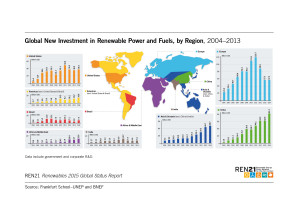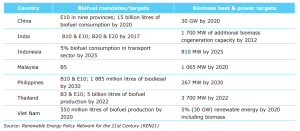In many countries renewables are outpacing fossil fuels in terms of new investments. In 2013 the global amount of investments (not including hydro) reached USD 270.2 billion, 17% up from previous year (source REN 21). In this context, dominated by investments in solar and wind power, several Asian countries

are increasingly looking at ways to use their biomass resources and are adopting ambitious targets for the development of biopower and biofuels. Global bio-power production increased approximately 9% in 2014, with China, Brazil, and Japan leading for capacity additions. Liquid biofuel production was up 9% in 2014, reaching its highest level to date. Although the United States and Brazil dominated overall volume, Asia experienced particularly high production growth rates. According to IRENA, the estimated global biomass demand, in the United States, China, India, Brazil and Indonesia together accounts for 56% of the total by 2030. while the global biomass supply is estimated to range from 97 EJ to 147 EJ per year, and the largest supply potential exists in Asia, followed by Europe including Russia (43-77 EJ). Let’s have a look at the bioenergy trends in the major asian countries.
China
The available biomass resources in China amount to 400 million tons TCE (tons coal equivalent). A large part of that is constituted by agricultural residues and straw, about 650 million tons, 50% of which can be utilized, that is equal to about 2.1 million tons of coal. This resources is still largely unused or burned in the fields (about 150 million tons annually) causing serious damages to the environment, human health, road transports and civil aviation. Forestry and wood waste is about 2.7 million tons, 30% of which can be utilized for energy, equal to approximately 0.5 million tons of coal. The conversion of manure and sewage into methane has the potential to produce approximately 1.0 million tons of coal equivalents. In the long-term, the potential exploitable biomass resource in China is equal to one billion tons of standard coal and by 2025 it is expected that China will generate 200 million tons TCE from modern bioenergy.
India
India’s total biomass potential is estimated at 18,000 – 23,000 MW, around six times more than the current installed capacity. Biomass provides over 30% of all the primary energy used in the country at present, the majority of the biomass generated in India comes from the agriculture sector, and is largely used for power generation. Besides direct combustion, gasifier-based power plants are providing a great solution for off-grid decentralized power and are lighting homes in several Indian states. By 2017 the country has a set the target to reach 1.5 GW power capacity from biogas, 3.2 GW from CHP bagasse, 324 MW urban waste, 850 MW from gasifiers. In addition, in 2009 India set an ambitious biofuel target of 20% biofuel blending in transports by 2017, both ethanol E20 in gasoline and biodiesel B20 in diesel. However this target will not be met since it was based on a massive production of oil from new large scale plantations of Jatropha, which have not delivered the expected results so far.
Thailand
In 2012, the biomass potential in Thailand represented 16,812.88 ktoe, in which 9,231.82 ktoe were from utilization as solid biomass fuel (agricultural residues),6,560.82 ktoe from biogas production, and 1,020.24 ktoe from biofuel production. The main energy crops are cassava, sugarcane, and oil palm. Currently the demand for these crops for biomass energy is increasing. It is estimated that the wastes and by-products from the industrial processing of these crops in large scale plants could generate enough energy to cover up to 15 % of the country’s energy demand, not including biomass wastes from SME’s, a big contribution to achieve the country’s target of 25% of RE in total energy consumption by 2021, with 4,390 MW of power biogas and biomass and 40ML/day biofuels.
Malaysia
As one of the countries with active agricultural activities and one of the largest producers of palm oil, Malaysia is blessed with abundant biomass resources which can be converted into alternative energy or useful eco-products. Annually, a minimum of 168 million tonnes of biomass waste is generated in Malaysia. With more than 423 mills in Malaysia, this industry generated around 80 million dry tonnes of biomass in 2010. From a supply-side perspective, by 2020, Malaysia’s palm oil industry is expected to generate about 100 million dry tonnes of solid biomass. This includes not only the empty fruit bunches (EFB), mesocarp fibres (MF) and palm kernel shells (PKS), but also the oil palm fronds and trunks. The Renewable Energy Policy and Action Plan sets a target of 4,000 megawatts of installed renewable energy capacity for 2030, raising the total installed capacity to 17 percent from less than 1 percent today. This target covers five individual types of renewable energy: biogas, biomass, solid waste, small hydro and solar photovoltaic (PV). The target for biogas alone is 410 MW installed capacity by 2030, which can only be achieved by the conversion of almost all mills to use biogas. The target for biomass to energy is to reach 1,340 MW by 2030.
Japan
The exploitable potential of domestic biomass for direct-burning in Japan is estimated in around 4.2 million dry tons. In 2012, the Basic Plan for the Promotion of Biomass Utilization set a target to combat global warming by utilizing about 26 million tons of biomass by 2020 (CO2 equivalent) and to develop at least 600 new biomass plants in different municipalities. This would equal to a growth of new biomass industries up to 500 billion yen (about U.S.$6.5 billion). Strengthening of independent and distributed energy supply system has become an important issue after the Great East Japan Earthquake and Fukushima nuclear power plant accident happened. In 2013, 5.6% of global electricity production was generated by renewable sources (excluding hydroelectricity), and biomass accounted for 36% of the renewables supply. By 2030 biomass should contribute to 10,000 kToe of biopower and 9,000 kToe of bioheat.
Besides these major countries, many other countries in the ASEAN region such as Vietnam, the

Philippines, and Indonesia are also developing programs for using their domestic biomass resources for power production as well as for transport biofuels, and lately more and more for biochemicals and bioproducts. These policies are driving many research and industrial initiatives in these countries, to develop advanced production and conversion technologies and to improve the existing ones in order to maximize the efficiency and cost competitiveness of using biomass resources.
The International Bioenergy (Shanghai) Exhibition and Asian Bioenergy Conference
Close interactions between the pure science, innovation and industrial exploitation of the results of research is fundamental to achieve these results. This is the scope of the International Bioenergy (Shanghai) Exhibition and Asian Bioenergy Conference 2015, which will take place from 21 to 23 October 2015. This new conference is designed to bring together from around the world scientists and industrial people implementing bioenergy technologies. The conference programme has in part been based on the successful format used for the European Biomass Conference and Exhibition, that takes places annually in Europe. The conference programme will cover a range of topics:
- biomass resources, assessment and production;
- biomass power and heat;
- biogas and bio-natural gas (biomethane);
- biofuels and future transportation energy;
- biomass utilisation strategies and sustaianability.
There will be a focus on how scientific innovations can be efficiently exploited, what are the needs of the cutting edge industries leading the way with scaling up of technologies, what are the research priorities in the minds of industry and policy makers and how can sustainability be maintained.


